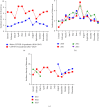Increased Incidence of Rhinovirus Pneumonia in Children During the COVID-19 Pandemic in Mexico
- PMID: 39512629
- PMCID: PMC11540899
- DOI: 10.1155/2024/8841838
Increased Incidence of Rhinovirus Pneumonia in Children During the COVID-19 Pandemic in Mexico
Abstract
Background: Human rhinovirus (HRV), traditionally recognized as the primary etiological agent of the common cold, has become the second most important viral agent in bronchopulmonary conditions, such as pneumonia and asthma exacerbations. During the COVID-19 pandemic, several viruses exhibited changes in their epidemiological behavior. This study aims to evaluate the clinical and epidemiological characteristics of children with HRV pneumonia before and during the pandemic in Mexico. Methods: A comparative ambispective longitudinal epidemiological study of two cohorts (prepandemic and pandemic periods) was carried out. Two databases were compared: one from 2010 to 2013 and the other from 2021 to 2023. Children under 5 years of age diagnosed with HRV pneumonia were included. Student's t-test, χ 2 tests, and logistic regression were used to assess risk factors associated with severe pneumonia. Incidence density was calculated as HRV cases per 10 new cases of pneumonia per month for each year. Results: During the pandemic, the age of presentation shifted from 5 months to 16 months. There was a higher incidence of HRV pneumonia in children during the pandemic, particularly in the second half of 2021, with a peak in July and August. In addition, there was an increase in severity (53% vs. 63%, p=0.006) and coinfections (51.3% vs. 76% p < 0.001). A higher prevalence of all risk factors was observed in the second cohort. Conclusions: During the pandemic, a shift toward older age, a higher percentage of coinfections, and increased severity associated to HRV pneumonia were observed. These findings highlight the need for the development and implementation of targeted prevention and treatment measures for HRV.
Keywords: HRV; Mexico; children; incidence; pandemic; pneumonia; respiratory; virus.
Copyright © 2024 Fanny Yasmin Ortega-Vargas et al.
Conflict of interest statement
Maria del Carmen Espinosa-Sotero is a member of the Pfizer, Sanofi, and MSD speaker's bureau; Daniel E. Noyola has participated as a member of the AbbVie, Sanofi Pasteur, and AstraZeneca speakers' bureau and served on the advisory board for Sanofi Pasteur, GSK, and Pfizer. Rosa María Wong-Chew is a member of the Seegene, Asofarma, AstraZeneca, and Sanofi Pasteur speaker's bureau and served on the advisory board for Sanofi Pasteur, Asofarma, and AstraZeneca. The rest of the authors declare no conflicts of interest.
Figures

Similar articles
-
Clinical and Th1/Th2 immune response features of hospitalized children with human rhinovirus infection.J Med Virol. 2020 Jan;92(1):26-33. doi: 10.1002/jmv.25587. Epub 2019 Sep 18. J Med Virol. 2020. PMID: 31475732 Free PMC article.
-
Detection and characterization of respiratory viruses causing acute respiratory illness and asthma exacerbation in children during three different seasons (2011-2014) in Mexico City.Influenza Other Respir Viruses. 2015 Nov;9(6):287-292. doi: 10.1111/irv.12346. Influenza Other Respir Viruses. 2015. PMID: 26289993 Free PMC article.
-
Impact of Human Rhinovirus Types and Viral Load on the Severity of Illness in Hospitalized Children With Lower Respiratory Tract Infections.Pediatr Infect Dis J. 2015 Nov;34(11):1187-92. doi: 10.1097/INF.0000000000000879. Pediatr Infect Dis J. 2015. PMID: 26267309
-
Rhinovirus-induced bronchiolitis and asthma development.Pediatr Allergy Immunol. 2011 Jun;22(4):350-5. doi: 10.1111/j.1399-3038.2011.01170.x. Pediatr Allergy Immunol. 2011. PMID: 21535176 Review.
-
Review on Clinical and Molecular Epidemiology of Human Rhinovirus-Associated Lower Respiratory Tract Infections in African and Southeast Asian Children.Pediatr Infect Dis J. 2018 Jul;37(7):e185-e194. doi: 10.1097/INF.0000000000001897. Pediatr Infect Dis J. 2018. PMID: 29893746
Cited by
-
Epidemiology and clinical characteristics of human rhinovirus in hospitalized children and adolescents with acute respiratory infections: a longitudinal study in Shenzhen, China (2019-2024).Virol J. 2025 Aug 14;22(1):280. doi: 10.1186/s12985-025-02901-9. Virol J. 2025. PMID: 40814124 Free PMC article.
References
-
- Ministy of Health. Specific Action Program. Prevention and Control of Acute Respiratory Infections (Pneumonia, Influenza and COVID-19) 2020-2024. 2021. https://www.gob.mx/cms/uploads/attachment/file/706929/PAE_IRA_cF.pdf .
LinkOut - more resources
Full Text Sources

